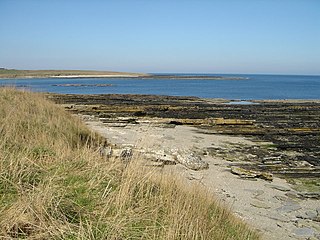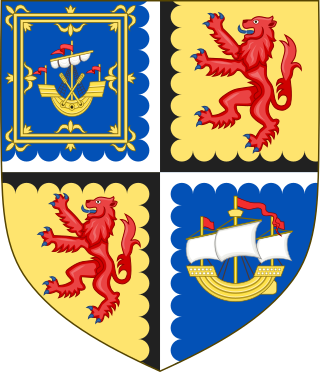
John Archibald Sinclair, 3rd Viscount Thurso,, known also as John Thurso, is a Scottish businessman, Liberal Democrat politician and hereditary peer who is notable for having served in the House of Lords both before and after a period in the House of Commons.

Thurso is a town and former burgh on the north coast of the Highland council area of Scotland. Situated in the historical County of Caithness, it is the northernmost town on the island of Great Britain. From a latitudinal standpoint, Thurso is located further north than the southernmost point of Norway and in addition lies more than 500 miles (800 km) north of London.

Archibald Henry Macdonald Sinclair, 1st Viscount Thurso,, known as Sir Archibald Sinclair between 1912 and 1952, and often as Archie Sinclair, was a Scottish politician and leader of the Liberal Party.

Caithness is a historic county, registration county and lieutenancy area of Scotland.

Viscount Thurso, of Ulbster in the County of Caithness, is a title in the Peerage of the United Kingdom. It was created on 11 June 1952 for the Scottish Liberal politician and former Secretary of State for Air, Sir Archibald Sinclair, 4th Baronet. His son, the second Viscount, served as Lord Lieutenant of Caithness from 1973 to 1995.
John Sinclair may refer to:

John Campbell, 1st Earl of Breadalbane and Holland, known as Sir John Campbell, 5th Baronet from 1670 to 1681, was a member of Scottish nobility during the Glorious Revolution and Jacobite risings and also known as "Slippery John". An astutely political man, Campbell was one of the men implicated in the Massacre of Glencoe.
The Lord-Lieutenant of Inverness is the British monarch's personal representative in an area which has been defined since 1975 as consisting of the local government districts of Inverness, Badenoch and Strathspey, and Lochaber, in Scotland, and this definition was renewed by the Lord-Lieutenants (Scotland) Order 1996. The area of the lieutenancy used to be the county of Inverness, which was abolished as a local government area by Local Government (Scotland) Act 1973. The districts were created, by the 1973 act, as districts of the two-tier Highland region and abolished as local government areas under the Local Government etc. (Scotland) Act 1994, which turned the Highland region into a unitary council area.
This is a list of people who have served as Lord Lieutenant of Worcestershire. Since 1719, all Lord Lieutenants have also been Custos Rotulorum of Worcestershire.
The Lord Lieutenant of Sutherland is the British monarch's personal representative in an area which has been defined since 1975 as consisting of the local government district of Sutherland in Scotland, and this definition was renewed by the Lord-Lieutenants (Scotland) Order 1996. Previously, the area of the lieutenancy was the county of Sutherland, which was abolished as a local government area by the Local Government (Scotland) Act 1973. The district was created, under the 1973 act as a district of the two-tier Highland region and abolished as a local government area under the Local Government (Scotland) Act 1994, which turned the Highland region into a unitary council area.
This is a list of people who have served as Lord Lieutenant of Moray, Scotland. Until 1928 the office was known as Lord Lieutenant of the County of Elgin.

Clan Sinclair is a Highland Scottish clan which holds the lands of Caithness, the Orkney Islands, and the Lothians. The chiefs of the clan were the Barons of Roslin and later the Earls of Orkney and Earls of Caithness.

Murkle (Murchill) is a small scattered hamlet, made up of East Murkle and West Murkle located one mile (1.6 km) east of Thurso, in Caithness, Scottish Highlands and is in the Scottish council area of Highland.
Sir George Sinclair, 2nd Baronet, was a Scottish politician and author.
John Sinclair, MBE was a Scottish official who served as the Lord Lieutenant of Caithness and the Provost of Thurso until his death in the 1970s. He was also a Grand Master of the Thurso Masonic Lodge. Sinclair was appointed Lord Lieutenant of Caithness the 10th of December 1965.
James Sinclair, 12th Earl of Caithness (1766–1823) was a Scottish noble, Earl of Caithness and chief of the Clan Sinclair, a Highland Scottish clan.

Thurso Castle is a ruined 19th-century castle, located in Thurso, Caithness, in the Scottish Highlands. Situated in Thurso East, off Castletown Road, east of the River Thurso, the site can be seen from across the river. The current castle ruins date to 1872; A large part was demolished in 1952, although there has been a fortress here since the 12th century. Part of the castle is still habitable and remains a home of the Viscounts Thurso.
Robin Macdonald Sinclair, 2nd Viscount Thurso, JP, was a Scottish landowner, businessman and Liberal Party politician.

George Sinclair was a Scottish nobleman, 6th Earl of Caithness, and chief of the Clan Sinclair, a Scottish clan of the Scottish Highlands.

George Sinclair, previously of Keiss, died 1698, was a Scottish nobleman, 7th Earl of Caithness and chief of the Clan Sinclair, a Scottish clan of the Scottish Highlands.









